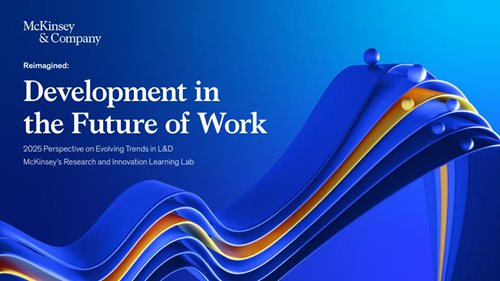We’re at a turning point. The way we think about learning and development is changing— and fast.
Last year at McKinsey, we launched a new AI-enabled tool to support aspects of our evaluation process. It was designed to streamline repeatable steps and help evaluators be more efficient. The rollout also presented the perfect opportunity to take a bold step into the future of learning.
Evaluation is core to our firm’s culture. It’s how we uphold our commitment to meritocracy, ensure every colleague gets meaningful feedback, and accelerate leadership development. And because evaluations are so critical, the role of the evaluator is especially important. Great evaluators don’t just assess performance—they coach, guide, and help others grow.
So we asked ourselves, “How could this AI-based tool, originally built as an aid to improve the efficiency of the performance evaluation process, also help us teach people to be great evaluators?” Instead of layering evaluator training on top of an already busy and time-consuming effort, we set out to help evaluators learn to get better at the role as they do the work. For example, we wrote sharper, more specific questions into the interview guide; built an antibias flag to help evaluators identify potential bias in the feedback they gather; and created a chatbot to support evaluators’ development of their feedback memo.
This idea—that learning shouldn’t be an add-on but integrated into how work gets done day to day—is what we believe will define the learning organizations of the future. We explore it in detail in our new report, Reimagined: Development in the Future of Work, and offer a few lessons here to get learning leaders started reflecting on what this might mean for their own organizations.
1. Reimagining a truly integrated development ecosystem
Today’s employees increasingly look for growth to be a natural part of their work experience, rather than an added obligation. However, in many organizations, learning and development can still feel like something outside of daily responsibilities—activities that require stepping away from “real work.”
For leaders, this presents both a challenge and an opportunity: to explore creative ways of weaving development into the fabric of everyday experiences—into daily routines, project workflows, and apprenticeship moments that already exist within teams. A promising approach involves identifying the tools, processes, and platforms employees use most frequently and adapting them to promote on-the-go learning.
But tweaking tools and workflows may only go so far. Supporting development more holistically may require leaders to redesign work in ways that ease administrative load and free up mental bandwidth for deeper engagement and learning. They can also help foster curiosity and growth by assigning employees to projects that offer relevant, real-time learning opportunities. When these elements come together effectively, organizations often see improvements in resilience, innovation, and long-term performance—driven by employees who recognize and respond to a clear commitment to their development.
How to get started:
- Log an early win to use as a lighthouse: Find a process that needs to be fixed and work with the business owner to embed developmental learnings into the redesign.
- Develop rotational apprenticeship programs for on-the-job learning, reinforced by personalized, data-based development plans.
- Encourage employees to participate in cross-functional projects and seek out mentorship from leaders who can expand their knowledge of different functions.
2. Reimagining responsible AI adoption
AI is reshaping how people work and how they learn—in fact, employees are three times more likely to be using gen AI than their leaders expect. The AI transformation is happening in real time. During our research of the report, AI rollout in learning and development appears to be uneven. Some degree of hesitation is understandable, given the rapid shifts in technology investment, hype cycles, and adoption priorities that have unfolded in the last 4-5 years.
So how do leaders meet the pace of change without misfiring? For starters, agile experimentation offers a more adaptive alternative to rigid planning. It enables learning and development teams to move faster, minimize risk, and make better decisions—grounded in accumulating evidence and informed intuition.
In terms of where to focus, AI presents two fundamental questions for learning and development leaders: (1) How can AI help us create better learning experiences faster? (2) What do our employees need to learn to build the fluency and competency in AI that our organization will need them to have going forward? While technical expertise in building and working with large language models is essential, it is ultimately the distinctly human qualities—such as judgment, empathy, and the ability to build relationships—that should and must remain the primary drivers of how AI is developed and applied.
How to get started:
Clarify the evolving skill sets needed in an AI-enabled world—especially human-centered capabilities such as emotional intelligence and creativity. Create space for individual exploration to foster creativity, spark innovation, and build technical fluency through practical, hands-on learning.
3. Reimagining resilience and adaptability
Burnout. Fatigue. Disengagement. The human toll of constant change is real—and rising. Resilience is a muscle that every organization and each employee will need going forward. So organizations will need to be deliberate about how they build it.
That means integrating learning for energy management, applying best practices for incorporating recovery into the employee life cycle, and supporting cross-generational learning—where employees at different stages of their careers share expertise, perspectives, and support to better navigate ongoing change together.
It also means designing work systems that enable adaptability, so people are better equipped to handle constant change with confidence and resilience. For example, pacing project plans to allow for recuperation, creating flexibility to meet diverse needs, and using AI to reduce administrative load so employees can focus on higher-value work.
How to get started:
Identify and acknowledge individuals who demonstrate resilient behaviors, helping to set a positive example for others. Consider integrating content into the learning curriculum that explores the foundations of resilience—such as managing stress, adapting to uncertainty, and sustaining motivation—and support each cohort in engaging with this topic as part of their broader development journey.
Learning and development teams are increasingly pivotal in helping organizations navigate a pace of change that continues to accelerate. At McKinsey, we’re leaning into this moment to evolve both ourselves and our approach. Reimagined: Development in the Future of Work reflects not only our perspective—but also the playbook we’re beginning to apply across our own teams. We invite other leaders to help shape what comes next: a more human, integrated, and future-ready approach to learning.
Download the full report:

.jpg?cq=50&mw=128&car=1:1&cpy=Center)


